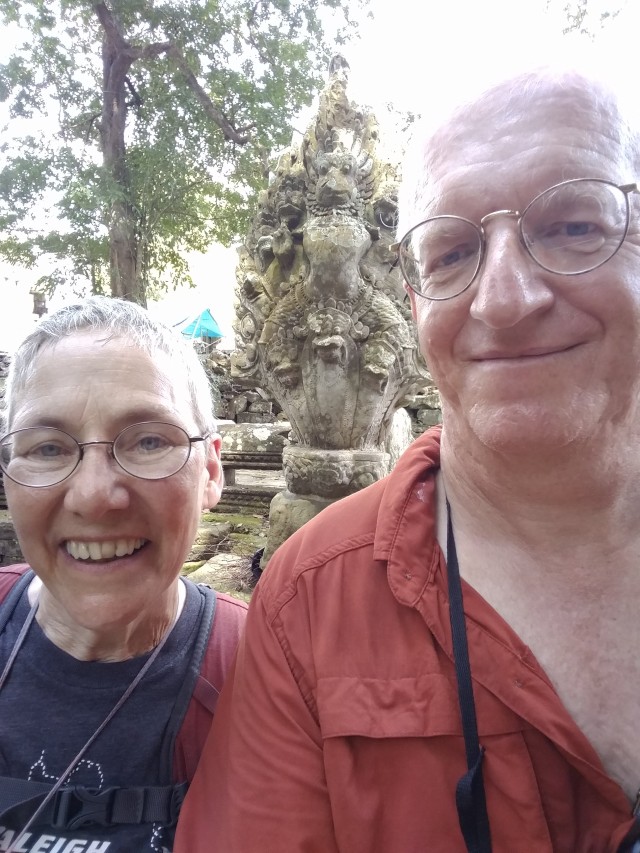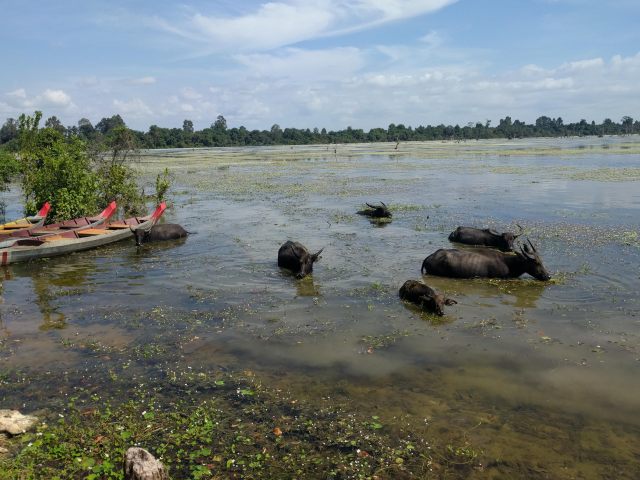
Some of the 51 “smiling buddha” towers at the Bayon Temple
A wat is a temple and they are everywhere in Cambodia and Thailand. Most are ornate, alive with monks, and serve an anchoring role in the community. To our sensibilities, however, and while artistically stunning, they are as gaudy as the Basilica of St. Terese in Lisieux and St. Paul’s Cathedral in London. It makes us appreciate all the more our inward sacraments as Friends rather than the outward expressions that can so easily become idols to worship and sources of human willfulness. On the other hand, they are expressions of our human yearning to be released from the bounds of time and place. And so we turn to the crumbling temples of Angkor Wat.
Seeing the temples of Angkor Wat Archeological Park, in Cambodia, has been on our “bucket list” for our trip home from New Zealand since before we left for this round-the-world-trip. Friends had told us that the ruins of the temples built by the Khmer people were astounding, and they were right.

Angkor Wat Temple, for which the entire archeological park is named.
The largest and most famous of the temples, Angkor Wat, is impressive both for it size and for the number of tourists who pour through it every day. While we will now always recognize the Cambodian flag, with its outline of Angor Wat, there were other parts of the Angkor Wat area that attracted us more strongly.
The first thing that hit us was the sheer number of temple ruins in what is now called the Angkor Wat Archaeological Park. In addition to the eponymous temple, there are hundreds more in the area, although only about two dozen are regularly visited. (The reclamation of these temples from the jungle was complicated by the civil war of the 1980s-90s, during which large areas of the jungle were laced with land mines. There are signs everywhere warning people not to wander off the paths, as not all the mines have been found and detonated).
Some of the temple ruins have been partially restored (largely funded by various French, Japanese, and Chinese agencies) but in many places, trees have insinuated themselves among the stones, creating incredible photo ops!
The explanation for the sheer number of temples is the tradition among the Khmer kings (from 10th century to 16th century) that every king had to build a minimum of three temples: one to honor himself, one to honor his ancestors, and one for the people to worship in. When the next king came to power, another three (minimum) temples would be constructed. It was a bit mind boggling to think that many of these temples were in regular use for a relatively short period of time – that they were, in effect, ‘disposable’ buildings of carved stone.
And the carving is incredible.
Our two favorite temples were Bayon (built around 1190) and Banteay Srei (built by a nobleman and dedicated in 967). In both cases, it was the carving that captured us.
Bayon is famous for two particular types of carving: towers (51 in all) that have the face of buddha carved on all four sides, and four long galleries of narrative bas-relief carving. Each carved gallery area is about 5 feet high and the four galleries amount to over a kilometer of carving! Two sides have mythological stories from the Hindu tradition, and two sides depict historical events. The fun in viewing these narratives is looking at the detail in the carving –




Look carefully in the middle — it appears that the man is turning around to look with a scowl at the woman behind him who is holding a turtle remarkably close to his bottom! This is the sort of detail that was fascinating to see.
Banteay Srei is a smaller, more intimate temple that is particularly known for its detailed carvings. Here, ornamentation is everywhere – door lintels are meticulously carved; mythological creatures stand guard at most entrances, apsaras (female spirits/dancers) catch the eye from nearly every wall. The effect is quite astonishing. The fact that the building is actually built on a smaller scale — even Marsha had to duck for some of the doorways — made the carvings more intimate.




We were also intrigued by the mix of hindu and buddhist decoration. Again, there is an historical explanation: the early Khmer kings followed the Hindu religion, and so the hindu symbols abound. But in the 13th century, the King converted to Buddhism. In most cases, the temples that were still in use at the time were converted to Buddhist use by the simple expedient of removing the large statues of Shiva or other Hindu divinities and replacing them with statues of the Buddha. (In some temples, they also chipped out the faces of some of the smaller carvings of hindu divinities).
Interestingly, since the snake is a potent symbol in both religions, the snake statues (or nagas) seem to have mostly survived. Most temples have the 7-headed cobra symbol somewhere.

We know that some people sit in these temples, reaching for their spiritual ambience. What struck us was the resources in time and people that were committed to building these temples successively over generations. A commitment to what end? If to enlightenment, was that ever achieved? Are the temples examples of detachment (cast away at the death of a king) or of futility? How peculiar it is to be human. And for us, in the end, we were worn out by them. Being not attached to a narrative involving temples representing the mythical mountain at the center of the world, all the stairs got to us as our sore thighs told us the day after!

We are glad we bought the 3-day pass and used it over 10 days, taking time between temple viewing to do other activities as well. After all, the town of Siem Reap may be the gateway to the historic Angkor Wat temples, but the area has many other attractions as well. (see other blog entries!). We also appreciated having a guide the first day, who could give some sense of the history and detail to look for, but going out on our own on a scooter for the 2nd and 3rd day, which allowed us to travel more at our own pace.
And, as an extra bonus, we got to see some wildlife, too!

Easy grazing for these water buffalo at the edge of one of the temples! Water buffalo and cows roam quite freely throughout Cambodia.

They look cute, but these monkeys will go after anything that looks like food. We actually saw them stalking a young child with a popsicle, getting closer and closer until her father grabbed teh popsicle and threw it to the monkey. One happy monkey, one sad kid!




Richard got to Angkor Wat in 1970 and it was actually shortly thereafter that Cambodia became a war zone. He always considered himself fortunate to have gotten there in time. It is well that there is still so much to see; he was fearful by the mid 70’s that the war damage had been substantial. Carole Aldrich McCleery
LikeLike